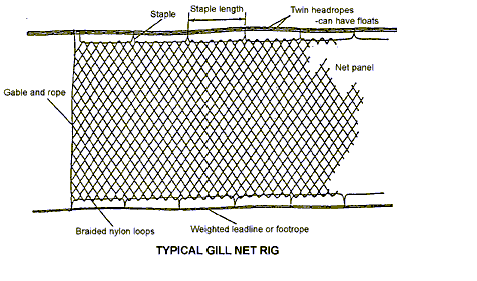|
2.16
The procedure when fishing fixed nets is similar irrespective of whether gill, tangle or trammel nets are being used. The nets are usually fished in groups or 'fleets' and bridles attach the end of each fleet to a heavy weight or anchor on the seabed. Each weight or anchor is secured to a marker buoy or dhan flag on the surface by a length of rope equal to about 1.5 to 2 times the depth of the water. Depths of water fished in this manner typically range from 15m to 140m with some fisheries going as deep as 1800m eg deep water monkfish caught in tangle nets
2.17
Lengths of nets can vary from between 50m to 200m and lengths of fleets from between 300m and 3000m. The amount of netting being fished, whether deployed in the water column or set on the seabed, at any one time can range from between 2km and 30km. Soak times, the time that a fleet is left on the seabed to fish, can range from a 6 hour tidal soak up to 72 hours. These figures are dependant on which species are being targeted and whether the area is also subject to trawling which may be in direct conflict with fixed net fisheries.
2.18
The nets are normally shot whilst steaming into the tide and are fished along the direction of the tidal stream rather than across it. This reduces the chance of the nets being swept over or tangled in the strong tidal conditions found in many sea areas around the UK. The dhan is thrown overboard and the vessel steams away paying out the rope until it reaches the anchor attachment, which is then dropped overboard. The fleet of nets follows until the full length has run out and the second anchor and dhan follow. Retrieval of gear is carried out in a similar fashion with first the dhan and anchor then the nets followed by the remaining dhan and anchor. Virtually all boats now use net haulers to help them retrieve their gear. They have a basic design consisting of a rotating drum covered with a rubber surface, which is driven by a hydraulic system run off the main engine. This creates friction between the net and drum allowing the hauler to take the strain and pull in the net.
2.19
Drift nets are generally used for pelagic and migratory species such as herring, mackerel, pilchards, sprats, bass, salmon and sea trout etc. they are normally rigged to form a curtain in the water and generally down-wind, with the vessel at the leeward end of the gear. The net is set out in a straight line and drifts with the current. Fish on passage swim into the net and are 'gilled'. The fishing depth of the net can be adjusted by adding weights to the bottom of the sheet and altering the float line. Single sheets of net are usually 50 or 100 metres in length. Varying numbers are joined together to form a 'fleet' of nets. The length and depth of the nets can vary considerably depending on the target species of fish and the nature of the seabed or depth or depth of water being worked.
2.20
Set nets and gill nets are sometimes used from the shore and in water too shallow for most seismic vessels. They are, however, also used from vessels at sea and are then marked by surface dhan buoys. When used offshore, the fishing vessel is usually in attendance. Dhan buoys are laid at intervals but it is not always possible to see 2 buoys at once. It is therefore difficult to be sure of the direction in which the nets are set. On fine ground the nets can extend to around 1500 metres in length. The practice of surrounding wrecks - 'wreck-netting' is also increasingly prevalent.
2.21
Tangle nets are single walled nets used to catch species such as monkfish, turbot and ray. While they resemble gill nets in their design they have a greater amount of slack netting and less flotation at the headline and a smaller vertical height of netting. The result is a much more loosely hung net, which effectively entangles species with protruding spines.
2.22
Trammel nets are three walled nets which can be used to catch a much wider variety of species ranging from cod and monkfish to plaice and sole. The net consists of three walls of netting in which a small fine meshed inner net is sandwiched between two outer walls of larger mesh netting. The three sheets of netting are attached to the floated headline and weighted footrope so that all three hang vertically in the water. Slack netting is ensured by setting the net loosely on the headline and footrope and by having the inner net depth measuring approximately twice the outer net wall depth. This ensures that there is always plenty of slack net for the fish to become entangled.
|
